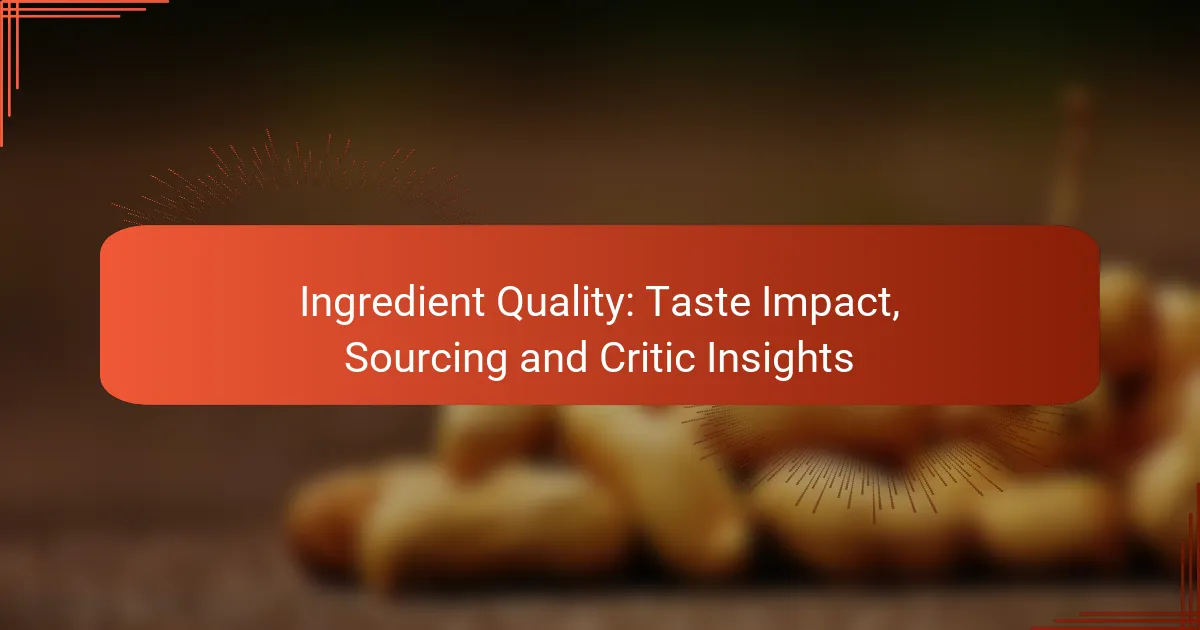Effectively sourcing organic ingredients requires a comprehensive understanding of various methods, quality standards, and buyer considerations. Ensuring that these ingredients meet sustainability and quality benchmarks is essential, as they must adhere to specific regional standards regarding farming practices and processing methods. Buyers should prioritize factors like price, supplier transparency, and ingredient traceability to align with ethical sourcing practices while maintaining high quality.

How to source organic ingredients effectively?
Sourcing organic ingredients effectively involves understanding various methods, evaluating quality standards, and considering buyer needs. By exploring different avenues, you can ensure that the ingredients meet your requirements for quality and sustainability.
Direct from local farmers
Sourcing organic ingredients directly from local farmers allows for fresher produce and supports the community. Establishing relationships with farmers can lead to better pricing and transparency regarding farming practices.
When purchasing directly, consider visiting farms to assess their organic certification and farming methods. This hands-on approach can help ensure that the ingredients align with your quality standards.
Through certified organic suppliers
Certified organic suppliers provide a reliable source of organic ingredients that meet established quality standards. These suppliers often have a wide range of products and can offer documentation proving their organic status.
When selecting a supplier, check their certifications and ask for references from other buyers. This can help you gauge their reliability and the quality of their offerings.
Using online marketplaces
Online marketplaces can be a convenient way to source organic ingredients, offering access to a variety of suppliers and products. Platforms like Amazon or specialized organic food sites allow you to compare prices and read reviews.
However, ensure that the sellers are reputable and that the products are certified organic. Look for seller ratings and customer feedback to avoid potential pitfalls.
Participating in co-ops
Joining a co-op can provide access to organic ingredients at lower prices through bulk purchasing. Co-ops often work directly with farmers and suppliers, ensuring a steady supply of fresh, organic products.
When considering a co-op, evaluate their membership requirements and the types of products they offer. This can help you determine if it aligns with your sourcing needs.
Attending trade shows
Attending trade shows focused on organic products can be an excellent way to connect with suppliers and discover new ingredients. These events often feature a variety of vendors showcasing their organic offerings.
Make the most of trade shows by preparing a list of questions and potential suppliers to meet. Networking at these events can lead to valuable partnerships and insights into market trends.

What quality standards should organic ingredients meet?
Organic ingredients must adhere to specific quality standards to ensure they are produced sustainably and without harmful chemicals. These standards vary by region but generally focus on farming practices, ingredient sourcing, and processing methods.
USDA Organic certification
The USDA Organic certification is a widely recognized standard in the United States, ensuring that products are grown and processed without synthetic fertilizers, pesticides, or genetically modified organisms (GMOs). To achieve this certification, farmers must follow strict guidelines and undergo regular inspections.
Products labeled as USDA Organic must contain at least 95% organic ingredients. The remaining 5% can include non-organic substances that are approved by the USDA. This certification provides consumers with confidence in the organic integrity of their food.
EU Organic certification
The EU Organic certification signifies compliance with European Union regulations for organic farming and production. Similar to the USDA standard, it prohibits the use of synthetic chemicals and GMOs, promoting environmentally friendly practices.
To be labeled as organic in the EU, products must contain at least 95% organic ingredients. The certification process includes rigorous inspections and adherence to specific farming methods, ensuring high-quality organic products for consumers.
Non-GMO Project Verified
The Non-GMO Project Verified label indicates that a product has been tested and meets strict standards for non-GMO status. This certification is crucial for consumers who want to avoid genetically modified ingredients in their food.
To obtain this verification, products must undergo a thorough evaluation process, including testing of ingredients and supply chain verification. This label helps consumers make informed choices about the genetic integrity of their food.
Fair Trade certification
Fair Trade certification focuses on ethical sourcing and fair labor practices in the production of organic ingredients. This certification ensures that farmers receive fair compensation and work under safe conditions, promoting sustainable livelihoods.
Products with Fair Trade certification often come with a premium price, reflecting the commitment to ethical practices. Consumers can support sustainable agriculture and social equity by choosing Fair Trade certified organic ingredients.

What buyer considerations are essential for organic ingredients?
When sourcing organic ingredients, buyers should prioritize factors such as price versus quality, supplier transparency, ingredient traceability, and the seasonality of ingredients. These considerations help ensure that the ingredients meet both quality standards and ethical sourcing practices.
Price vs. quality balance
Finding the right balance between price and quality is crucial when purchasing organic ingredients. While organic products often come at a premium, lower-priced options may compromise on quality or authenticity. Buyers should evaluate the cost in relation to the ingredient’s quality, ensuring that the price reflects its organic certification and production standards.
Consider setting a budget range that aligns with your quality expectations. For instance, organic spices might range from $10 to $30 per pound, depending on their sourcing and processing methods. Always compare similar products to make informed decisions.
Supplier transparency
Supplier transparency is vital for verifying the authenticity of organic ingredients. Buyers should seek suppliers who openly share information about their sourcing practices, certifications, and production processes. This transparency builds trust and helps ensure compliance with organic standards.
Request documentation such as organic certificates and audit reports. Engaging with suppliers who are willing to provide detailed information can prevent potential issues related to ingredient quality and sourcing integrity.
Ingredient traceability
Ingredient traceability allows buyers to track the origin of organic products, ensuring they meet quality and safety standards. A robust traceability system helps identify the supply chain journey from farm to final product, which is essential for maintaining organic integrity.
Look for suppliers that implement traceability systems, such as batch numbers or QR codes on packaging. This not only enhances accountability but also aids in addressing any quality concerns that may arise.
Seasonality of ingredients
Understanding the seasonality of organic ingredients is important for sourcing fresh and high-quality products. Seasonal variations can affect availability, pricing, and flavor profiles. Buyers should be aware of when specific ingredients are in season to make informed purchasing decisions.
For example, organic tomatoes are typically in season during the summer months, while certain greens may be more abundant in spring. Planning purchases around these seasonal cycles can lead to better quality and potentially lower costs.

How do organic ingredient sourcing methods vary by region?
Organic ingredient sourcing methods differ significantly across regions due to varying agricultural practices, regulations, and consumer preferences. Understanding these differences is crucial for buyers looking to ensure quality and compliance in their organic products.
North American sourcing practices
In North America, organic ingredient sourcing is largely governed by the USDA National Organic Program (NOP), which sets strict standards for organic farming and processing. Farmers must adhere to specific practices, such as avoiding synthetic pesticides and fertilizers, and maintaining organic integrity through proper record-keeping.
Buyers often seek local sources to reduce transportation costs and support regional economies. Additionally, many North American consumers prefer products that are certified organic, which can enhance marketability and consumer trust.
European sourcing regulations
European organic ingredient sourcing is regulated by the European Union’s organic farming regulations, which are among the strictest in the world. These regulations require that organic products are produced without synthetic chemicals and that they meet stringent traceability requirements from farm to table.
In Europe, there is a strong emphasis on sustainability and biodiversity, leading to practices that often include crop rotation and the use of organic seeds. Buyers should be aware of the EU organic logo, which signifies compliance with these rigorous standards and can influence purchasing decisions.
Asian organic farming techniques
Asian organic farming techniques vary widely, influenced by local traditions and agricultural practices. Countries like Japan and India have developed unique methods, such as permaculture and integrated pest management, which focus on ecological balance and sustainability.
Buyers in Asia often prioritize relationships with local farmers to ensure quality and authenticity. Understanding regional certifications, such as India’s National Programme for Organic Production (NPOP), can help buyers navigate the complexities of sourcing organic ingredients in this diverse market.

What are the emerging trends in organic ingredient sourcing?
Emerging trends in organic ingredient sourcing focus on sustainability, transparency, and local engagement. As consumer awareness grows, businesses are adapting their sourcing methods to meet these demands while ensuring high-quality standards.
Increased demand for local sourcing
Local sourcing is gaining traction as consumers prefer ingredients that are fresh and sustainably produced within their region. This trend not only supports local economies but also reduces transportation emissions, aligning with eco-friendly practices.
To effectively implement local sourcing, businesses should establish relationships with nearby farmers and suppliers. This can involve attending local farmers’ markets or joining regional cooperatives to ensure a steady supply of organic ingredients.
Adoption of blockchain for traceability
Blockchain technology is increasingly used in the organic ingredient supply chain to enhance traceability and transparency. By recording every transaction on a decentralized ledger, stakeholders can verify the origin and quality of ingredients, which builds consumer trust.
Companies considering blockchain should evaluate their existing supply chain processes and identify areas where transparency can be improved. Implementing this technology may involve initial costs but can lead to long-term benefits, such as reduced fraud and enhanced brand reputation.



